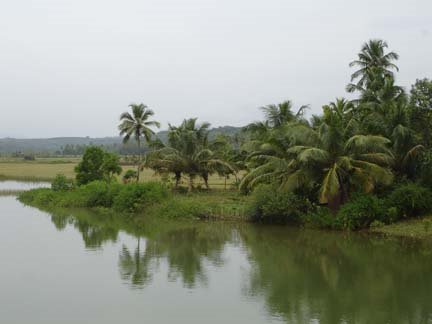The word ‘Kudla’ is an ancient name and refers to the city of Mangalore.What is the meaning of this word Kudla? If you answer me that ‘Kudla’ means ‘kooDla’ or a confluence of two rivers, you may not be precisely reflecting the original meaning of this word!
Let us analyse this controversy.
Fluvial Geography of Mangalore city at present
Yes! Most of us, including this blogger, were under the impression that ‘kuDla’ means a confluence region of two rivers, Gurpur and Nethravati. You can also find this explanation in some of the earlier posts filed in this blog or write-ups published in periodicals.This opinion is also shared by the mighty Tulu Nighantu.
The Tulu Nighantu lists three meanings for the word Kudla (p.823):
1. Mangalore town, a confluence of two rivers.
2. Again. [The Tulu usage ‘kuDala kuDala’ means to repeat again and again.]
3. (a) a confluence of two rivers, (b) a confluence of a stream and a river. [Latter, also known as ’KooTel’]
Thus the cited entries 1 and 3 above suggest emphatically that kuDla means a confluence.
The assertion that KuDla= confluence is based on the word koodla as in place names ‘KooDala Sangama’ (of Basaveshwara fame, Bagalkot district) or ‘KooDali’ (a confluence of Tunga and Bhadra rivers, Bhadravati Taluk).
Paleo-geography of Mangalore:
In Mangalore we have a confluence of Gurupur and Nethravati rivers between Bengare and southwestern corner of Mangalore city.However,the confluence of Gurpur with Nethravati River occurred relatively recently ie in the year 1887.That is to say that confluence as seen now did not exist in the historical past! Thus ancient word ‘kudla’ may not be referring to any recent confluence!
Secondly, the word ‘Kudla’ even though applied at present to Mangalore as a whole in general, was originally referring to apart of present Mangalore, especially the Kodialbail area.Kudla was the Kudla bail to begin with which with passage of time changed into Kodial-bail or simply Kodial. This Kudla bail or Kodial bail is a valley region once upon a time occupied by Phalguni River which changed its course (probably around 7th Century CE or earlier) further northwards in the course of time.
Thus the truth is that KuDla is not kooDla!
It was an fertile river plain in the antiquity that was amenable for good agricultural crops!
Let us explore the alternative explanation.
Agricultural settlement
Dr Gururaj Bhat (1963) in his work ‘Tulunadu’ passingly remarked that Kudla is not ‘kooDla’ or a confluence (p.29, 2009 edition). He pointed out that Kuduva tribes iniated agricultural practices in ancient Tulunadu.Kuduva tribes in different areas and times were also known as Kudi, Kudu, Kudubi, Kudumbi, Koda, Kunubi etc. The Munda word kuDa reffered to ‘good agricultural lands’ and those tribes associated with agriculture were known as KuDi or KuDubi.
Ku+ Da + ala. = An agricultural settlement on the river plains.
Ku=good, Da=land, earth. KuDa=good land, agricultural land. Ala= river plain or habitation on the river plain.
There are many villages in the Karavali having the prefix of KuDu.
KuDupu .(A village in eastern Mangalore on Nanthur -Vamanjur NH13 road).
KuDuma. (Old name for Dharmastala, Belthangadi taluk).
KuDumbi hittil ( A residential area near Falnir, Mangalore).
KuDipäDi .( A village near Vamadapadavu, Bantval taluk)
Kudne, Maharastra
Kudle beach, Gokarna, Uttar Kannada.
Note that in above place names suffixes –pu, Ne,-le etc are indicative of settlement or habitation areas.
According to Dr Padur Gururaja Bhat (ibid) ‘kuDu’ later transformed into ‘koDu’ as seen in place names KoDiala,KoDimbadi, KoDavur,KoDlaDi,KoDangala, KoDange etc.
KuDu
KuDu also represents horse gram which incidentally is the first agricultural food crop grown in southern India. Agriculture in southern Indian River plains was in vogue ca. 2000-2500 BC according to archeo-botanical studies. This takes the age of the place name Kudla to that period, ca 2000-2500BC. The word KuDäla is derived from ancient and pre-Dravidian Munda languages of southern India.
®






